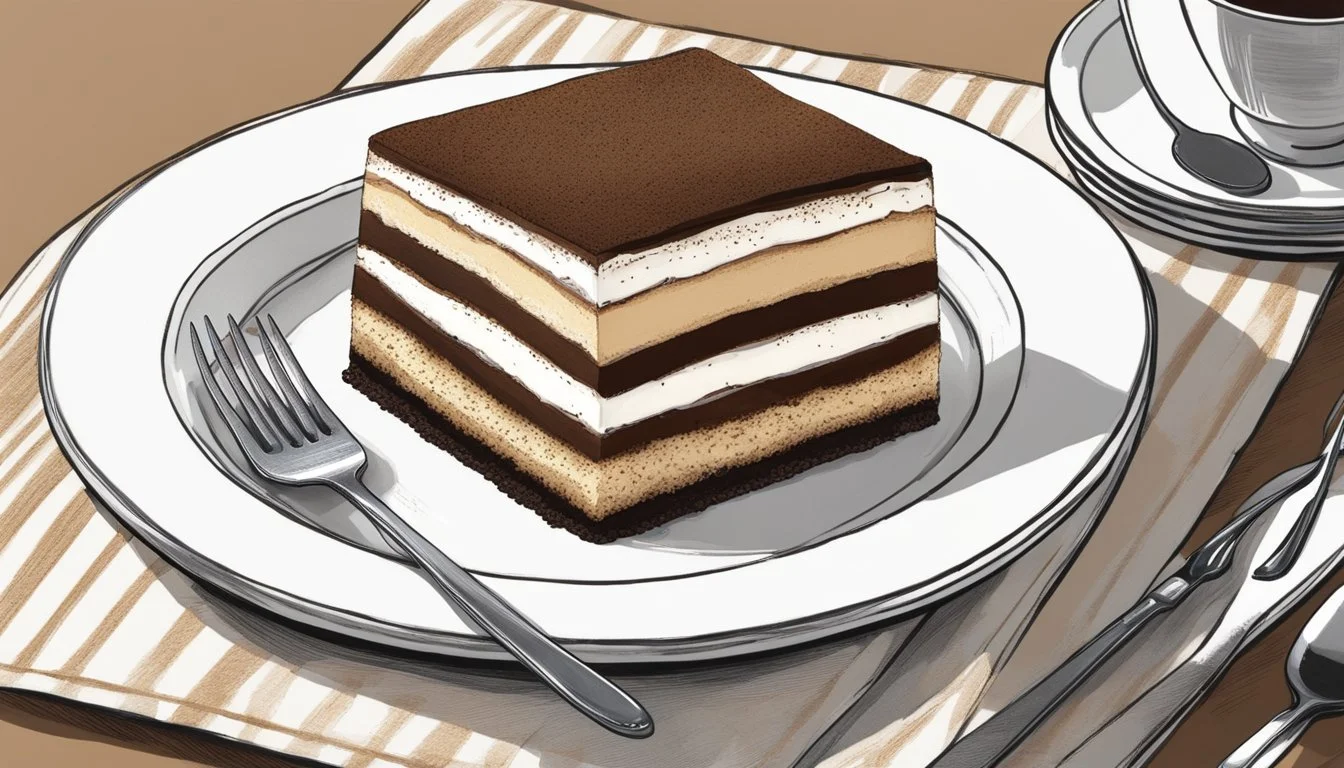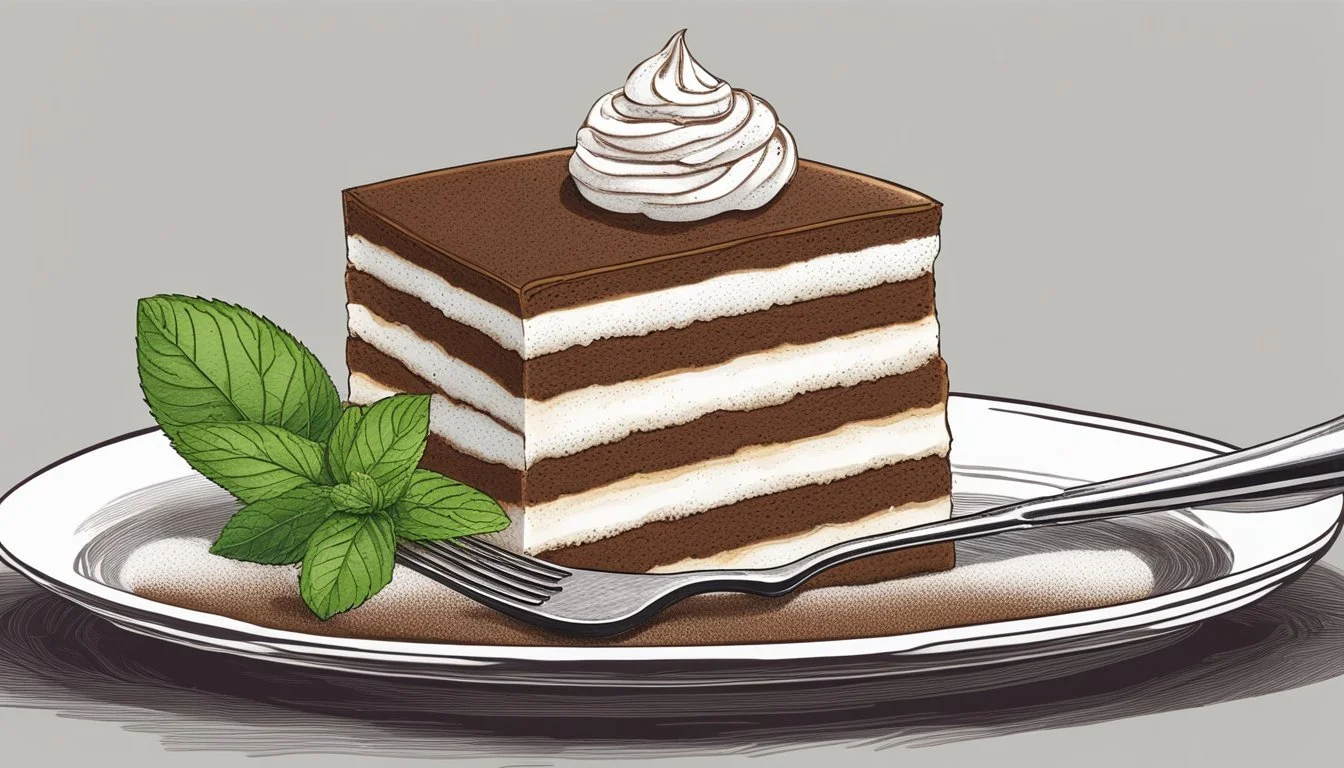How Do You Eat Tiramisu?
Mastering the Art of Savoring This Classic Dessert
Tiramisu is a beloved Italian dessert known for its rich layers and exquisite combination of flavors. It consists of ladyfingers dipped in coffee, layered with a whipped mixture of eggs, sugar, and mascarpone cheese, and flavored with cocoa. This dessert is often regarded as a comfort food with its creamy texture and robust coffee-infused flavor, making it a favorite among both casual diners and gourmet enthusiasts.
Properly eating tiramisu is an experience that should be savored. The dessert is typically served chilled and has a layered construction that is best appreciated when each forkful includes all the components, ensuring a harmonious blend of the coffee-soaked ladyfingers, the velvety mascarpone mixture, and the dusting of cocoa powder. As a dessert that combines different textures and flavors, tiramisu delivers a complex taste profile in every bite.
To fully enjoy tiramisu, it is best eaten with utensils, using a fork to gently cut through the layers, bringing a little bit of each element onto the utensil for a complete taste. This allows one to appreciate the subtle balance between the bitterness of the cocoa and coffee and the sweetness of the mascarpone cream. Whether it culminates a fine dining experience or is enjoyed as a treat, tiramisu provides a delightful end to any meal.
Understanding Tiramisu
Tiramisu is an Italian dessert that has become emblematic of Italian cuisine. A classic tiramisu recipe involves a specific layering of ingredients to create its unique taste and texture. Authentic Italian tiramisu begins with savoiardi cookies, which are Italian ladyfingers, dipped in strong espresso to provide a robust coffee flavor. These are layered with a mixture of eggs, sugar, and mascarpone cheese — an essential component that gives tiramisu its creamy texture.
The traditional way to prepare the eggs is by separating them into yolks and whites. The yolks are typically beaten with sugar until creamy, while the whites are whipped into soft peaks and later folded into the mascarpone mixture. This process helps achieve a balanced sweetness and a light, airy consistency. A traditional tiramisu recipe might also include a splash of liquor, such as Marsala wine or rum, although alcohol is optional.
Finally, tiramisu is dusted with cocoa powder before being left to set in the refrigerator for several hours. This chilling period allows the flavors to meld and the dessert to firm up, which makes serving easier. When done right, a slice of Italian tiramisu presents itself with distinctive layers, a moist yet firm texture, and a harmonious blend of rich mascarpone, bold coffee, and cocoa flavors.
In essence, an authentic tiramisu offers a taste of Italy's rich dessert tradition, combining simple yet high-quality ingredients that epitomize the Italian approach to cooking.
Ingredients Overview
Creating an authentic tiramisu requires careful selection of high-quality ingredients, with each component playing a crucial role in the final taste and texture of the dessert. The mastery of the dish lies in the harmony between the creamy layers and the robust elements of coffee and cocoa.
Main Components
Tiramisu is composed of several key ingredients that work together to form its unique flavor profile. Properly balancing these elements is essential for an authentic taste:
Egg yolks and sugar are whipped to create the base of the creamy filling, often referred to as zabaglione.
Mascarpone cheese, a rich Italian cream cheese (how long does cream cheese last?), is blended with the zabaglione for smoothness.
Heavy cream, sometimes replaced by whipped cream, is folded into the mixture to add lightness.
Ladyfingers, also known as Savoiardi, are dipped in a mixture of espresso or strong coffee, and sometimes a touch of alcohol such as Marsala wine, rum, brand, cognac, vin santo, or Kahlua, to add depth of flavor.
Cocoa powder is sifted on top to finish the dessert, providing a slightly bitter contrast to the sweet, creamy layers below.
These main components are layered in a specific order: a foundation of coffee-soaked ladyfingers followed by the creamy mascarpone mixture, and repeated, usually culminating in a final dusting of cocoa powder. Some variations may also include flavorings such as vanilla extract to enhance the overall taste.
Mascarpone Cheese
At the heart of tiramisu is mascarpone cheese.
Texture: Mascarpone is known for its smooth, creamy consistency, which is thicker than most other cream cheeses.
Flavor: It has a mild yet distinct flavor, with naturally sweet notes that complement the bolder coffee and cocoa components of tiramisu.
When selecting mascarpone, one should opt for a brand that is fresh and of high quality, as this will significantly impact the flavor and texture of the dessert. It's also important to note that while some dessert recipes may permit cream cheese as a substitute, traditional tiramisu relies on the unique characteristics of mascarpone cheese to achieve the correct balance and richness.
Required Equipment
For the preparation of tiramisu, certain tools are indispensable to achieve the desired precision and presentation. This section details the equipment required for creating a delectable tiramisu.
Pans and Dishes: A rectangular baking dish is traditional for assembling tiramisu. The size of the dish should be chosen based on the desired quantity of the dessert. If one aims to create individual servings, ramekins serve as an excellent alternative.
Rectangular baking dish (for standard preparation)
Ramekins (for individual servings)
Mixing Tools: An electric mixer is vital for whipping the mascarpone mixture to the required fluffiness. While a whisk can be used, an electric mixer ensures a consistent and smooth cream.
Electric mixer (preferred for consistency)
Coffee Preparation: To infuse the ladyfingers with rich coffee flavor, a moka pot is ideal for brewing a strong espresso. This brewing equipment captures the essence of Italian coffee, which is central to the taste of tiramisu.
Moka pot (for authentic espresso brew)
In summary, the proper equipment can ease the process and enhance the tiramisu's authenticity. An adequately sized baking dish or ramekins, an electric mixer, and a moka pot are recommended for budding tiramisu crafters.
Preparing the Layers
Tiramisu layering is a delicate process that involves precise assembly and specific techniques to ensure the dessert's structural integrity and flavor balance.
Assembling the Tiramisu
The assembly of tiramisu begins with a layer of ladyfingers, also known as savoiardi biscuits or Pavesini. The ladyfingers should be dipped quickly—no more than 1 to 2 seconds—into coffee before they are placed at the bottom of the chosen dish. A common mistake is over-soaking the biscuits, which leads to a soggy dessert. Ladyfingers serve as the foundation of the tiramisu, providing a sponge-like base that absorbs flavors and gives the dessert its characteristic texture.
Layering Techniques
A proper tiramisu requires the mascarpone cream to be evenly spread over the layer of ladyfingers. One should use about half of the mixture and smooth it gently to avoid dislodging the soaked biscuits.
The process is then repeated to create multiple layers, typically two, but one can add more depending on the dish's depth.
Step Tip 1. Add first layer of ladyfingers Work quickly to avoid ladyfingers dissolving in coffee. 2. Spread mascarpone cream Apply an even layer to cover the biscuits. 3. Repeat layering Continue layering with remaining ladyfingers and cream. 4. Final Touch Finish with a dusting of cocoa powder for a classic look.
It's crucial to remember that tiramisu is a no-bake dessert, and the consistency of the layers will firm up during refrigeration, which is essential for the tiramisu to set properly before serving. The layers should meld together harmoniously, creating a balance between the bold coffee-soaked ladyfingers and the smooth, rich mascarpone cream.
Mixing Techniques
The art of tiramisu lies not only in the quality of its ingredients, but also in the technique used to mix them. Mastery in beating egg yolks to achieve the right consistency and whipping cream to form stiff peaks is essential in creating the light and creamy texture that tiramisu is renowned for.
Beating Egg Yolks
Egg yolks contribute to the custard base, sometimes known as sabayon, which imparts a rich and creamy texture to tiramisu. They should be beaten until they become pale and have tripled in volume. Here’s how to ensure a creamy base:
Start with room-temperature egg yolks for more efficient whipping.
Gradually add sugar as you beat the yolks, which helps them to thicken.
A proper sabayon is smooth and forms a slight ribbon when the beater is lifted.
Whipping Cream to Perfect Stiff Peaks
Whipped cream provides the airy texture crucial for a light and fluffy mascarpone cream. Achieving stiff peaks in whipping cream involves:
Using cold cream and equipment, as the coldness helps the cream form peaks.
Beating until the cream holds a peak when the whisk is withdrawn.
Remember to:
Avoid over-whipping, as cream can quickly become grainy and turn into butter.
Fold whipped cream gently into the mascarpone mixture to maintain an airy batter.
By adhering to these mixing techniques, one ensures a tiramisu that is both airy and creamy, as the mascarpone cream becomes a perfect blend of richness and lightness.
Flavor and Texture Profile
Tiramisu's distinctive flavor and texture are the result of a careful balance between its rich, creamy elements and the deep, aromatic components. The dessert should have a harmonious contrast of flavors and a layered texture that is both smooth and spongy.
Creating the Ideal Tiramisu Texture
The ideal tiramisu texture is achieved by combining pale yellow egg yolks with granulated sugar until the mixture is thick. To this base, mascarpone cheese—a creamy, rich Italian cheese—is added to provide the dense yet soft texture that tiramisu is known for. Heavy whipping cream is whipped to stiff peaks and then folded into the mascarpone mixture. This lightens the cream and contributes to the luxurious mouthfeel. Alternating these creamy layers with coffee liqueur-soaked ladyfingers forms a dessert that presents a delicate interplay between a velvety cream and a lighter, spongy element.
Key Ingredients for Texture:
Mascarpone cheese: Rich and creamy
Heavy whipping cream: Whipped to create a light consistency
Ladyfingers: Soaked briefly to remain spongy yet firm
Balancing Sweetness and Bitterness
Tiramisu achieves a masterful balance of flavors through its sweet and bitter components. The dessert's sweetness mainly comes from the mascarpone and sugar mixture, which contrasts with the bitterness from the coffee and chocolate elements. Carefully dipping the ladyfingers in a blend of dark and rich coffee, occasionally enhanced by dark rum or another coffee liqueur, imparts the signature espresso tone without overwhelming the dessert. Finally, a dusting of cocoa or garnish of grated or shaved chocolate—preferably bittersweet—provides a finishing touch that deepens the flavor profile.
Key Ingredients for Flavor Balance:
Coffee/espresso: Provides a bittersweet counterpoint
Dark rum or coffee liqueur: Deepens the coffee flavor and adds richness
Cocoa powder, grated, or shaved chocolate: Enhances the dessert with a bittersweet nuance
Safety Considerations
When consuming tiramisu, safety is paramount due to the inclusion of raw egg yolks in many traditional recipes. The main concern associated with raw eggs is the risk of salmonella infection, which can cause severe food poisoning.
Pasteurized eggs are recommended as they have been heat-treated to kill bacteria without cooking the egg. When purchasing eggs specifically for making tiramisu, one should ensure they are labeled as pasteurized.
If one opts for fresh eggs, it is crucial to follow strict hygienic practices. This includes:
Procuring eggs from a reliable source.
Ensuring that they are refrigerated properly.
Checking the sell-by date to confirm freshness.
Washing hands thoroughly before and after handling the eggs.
To minimize risks:
Do not allow eggs to come in contact with other ingredients.
Avoid cross-contamination with different utensils and surfaces.
Prepare the dessert shortly before consumption to reduce the time eggs are at room temperature.
If concerned about the safety of raw egg yolks:
One can opt for recipes that cook the yolks or use an egg substitute.
Such recipes are readily available and provide similar taste profiles and consistencies.
In summary, by selecting pasteurized eggs or adhering to stringent hygiene standards with fresh eggs, individuals can enjoy tiramisu safely. It's essential to be conscientious of these safety considerations to prevent foodborne illnesses.
Serving and Presentation
The elegance of tiramisu lies in its layers and the way it is served, showcasing the creamy and decadent dessert to its full potential.
Chilling and Serving
Tiramisu needs to be properly chilled before serving to ensure that the layers set and flavors meld. It is generally recommended to refrigerate the dessert for at least 4 hours, although making it a day ahead can enhance its taste. When ready to serve, use a spatula or a pie server that can support the entire slice to maintain its structure.
Refrigerate: Ideally overnight
Serve: With a supporting server
Decorative Touches
The presentation of tiramisu can be as simple or as elaborate as desired. For a traditional look, a neat dusting of cocoa powder on top right before serving adds both flavor and a classic finish. For those seeking more personalized servings, individual glasses can be utilized, layering the ingredients for both appeal and convenience.
Cocoa Powder: Added just before serving
Individual Glasses: Can be used for personalized presentation
The layers should be visible when served, displaying the alternating textures. Whether in a large dish or as a single-serving presentation, tiramisu should be served with attention to detail, embodying the charm of this beloved Italian dessert.
Pairing Recommendations
When enjoying tiramisu, certain beverages can enhance the dessert experience. Coffee, often used in tiramisu's layers, naturally pairs well with the dessert. A robust espresso can complement the rich flavors of coffee and chocolate within tiramisu. The key is to match the intensity of the espresso with the richness of the dessert to maintain balance.
For those who enjoy alcohol, a coffee liqueur can intensify the coffee notes in tiramisu. Its sweet and complex profile echoes the dessert's own character without overpowering it. Similarly, Marsala wine—a fortified wine from Sicily with a unique flavor—can offer a harmonizing effect. It is traditionally used in the making of tiramisu itself and, as a drink, its caramelized sugary notes can amplify the creamy sweetness of the mascarpone cheese.
Here are some confident recommendations for pairing tiramisu with beverages:
Beverage Type Specific Name Reason for Pairing Espresso Coffee Italian Espresso Intense coffee flavor enhances tiramisu Coffee Liqueur Kahlua or Tia Maria Complementing coffee notes Fortified Wine Marsala or Vin Santo Sweetness matches the dessert
Another wonderful match is Vin Santo, an Italian dessert wine. Its nutty and caramel notes provide a delightful counterpart to the sweetness and texture of tiramisu. When choosing an alcoholic pairing, one should look for options that are at least as sweet as the dessert to prevent a muted palate experience.
In summary, both coffee and dessert wines offer delicious harmony with tiramisu, whether to echo its coffee notes or to complement its sweetness and textures.
Culinary Variations
Tiramisu boasts numerous creative adaptations that cater to diverse palates and dietary restrictions while maintaining the essence of the traditional Italian dessert.
Alternative Tiramisu Recipes
Chocolate Mousse Tiramisu: A select few recipes reinvent tiramisu by combining it with chocolate mousse, offering a sumptuous experience with every spoonful. It's essential to maintain the balance of flavors, sometimes by adding just a splash of spirits such as Marsala wine or liqueur to the mousse rather than overwhelming it.
Light Tiramisu: Some variations aim for a lighter dessert experience, focusing on reducing the calorie count. Bakers may substitute the traditional mascarpone with lighter creams or cream cheese while still layering with espresso-soaked ladyfingers.
Non-Alcoholic and Allergen-Free Alternatives
Alcohol-Free Tiramisu: Many prefer their tiramisu without alcohol, acknowledging dietary preferences or restrictions. For these versions, the ladyfinger biscuits are typically dipped in pure espresso or a coffee mixture devoid of Marsala or liqueur, keeping the robust coffee flavor intact.
Gluten-Free and Allergen-Free: Adapting the recipe for gluten sensitivities involves replacing traditional ladyfingers with gluten-free alternatives. It's possible to use alternative binding ingredients like gluten-free flour combinations to create a dessert that everyone can enjoy, regardless of their allergies.
No Cream and Dairy-Free: For those avoiding dairy, some inventive chefs have found success with substitutions such as coconut cream or silken tofu blended with other ingredients to mimic the rich mascarpone layer, creating a tiramisu that caters to a wider audience.
By considering these variations, tiramisu remains a versatile dessert option capable of accommodating a range of tastes and dietary needs.
Nutritional Information
When examining the nutritional composition of tiramisu, one finds that it is a dessert with a significant calorie count. This is primarily due to the presence of high-fat content and sugars. A typical serving size of 100 grams of tiramisu can contain around 283 to 310 calories, with variations arising from different recipes and preparation methods.
Fat: Tiramisu is rich in fats, accounting for about 58% of the total caloric content. These fats can be sourced from ingredients such as mascarpone cheese and egg yolks, which are fundamental in creating the creamy texture of the dessert.
Carbohydrates: Carbohydrates generally make up around 35% of the caloric content, with a notable portion of this coming from sugars. It is important for those monitoring their sugar intake to note that tiramisu can be high in sugars due to components like ladyfingers soaked in syrup or alcohol, and the sweetened mascarpone cream.
Proteins: In terms of protein, tiramisu offers a smaller percentage, typically around 7%. The proteins in this dessert can be derived from the eggs and cheese used in the recipe.
The dessert lacks the benefits of whole foods since it is not a source of complex carbohydrates, fiber, or essential micronutrients. Tiramisu should ideally be regarded as an indulgence rather than a significant part of one's diet. The occasional slice can fit into a well-rounded eating pattern when consumed in moderation.
Care should be taken by those with dietary restrictions or specific nutrition goals to account for this dessert's rich nature. Those looking for the pleasure of tiramisu with fewer calories may wish to seek out recipes with adjusted ingredients that decrease the fat and sugar content.
Cultural Significance
Tiramisu holds a distinguished place in Italian culinary culture. Originating from Italy, tiramisu is more than a mere dessert; it embodies tradition and regional pride. The name tiramisu, meaning “pick me up” in Italian, reflects the dessert's uplifting blend of flavors.
Italian Recipe: Traditional recipes for tiramisu call for savoiardi (ladyfingers), espresso, mascarpone cheese, eggs, sugar, and a dusting of cocoa powder. This combination has secured tiramisu's reputation as an ultimate Italian treat.
Italian Tiramisu: The classic Italian tiramisu is a testament to Italy’s gastronomic ingenuity. Its layers of coffee-soaked savoiardi and rich mascarpone cream create an alluring contrast, marking it as a hallmark of Italian dessert cuisine.
Authentic Tiramisu: Authenticity in tiramisu preparation is key to experiencing its true cultural essence. Authentic recipes advocate for high-quality, fresh ingredients and adherence to traditional layering techniques to maintain the integrity of the dessert's heritage.
Classic Tiramisu: The classic tiramisu recipe, unaltered through time, offers a window into Italy's past. It is a dessert that resonates with the Italian ethos of simplicity and quality, always mindful of the delicate balance of flavors.
Within Italy, regions vie for the honor of being tiramisu’s birthplace, with Veneto and Friuli-Venezia Giulia at the forefront. Regardless of its precise origins, tiramisu is universally cherished, symbolizing Italy’s rich culinary landscape to both Italians and an international audience. Each bite of this sumptuous dessert is a tribute to the country's profound influence on the world of gastronomy.













